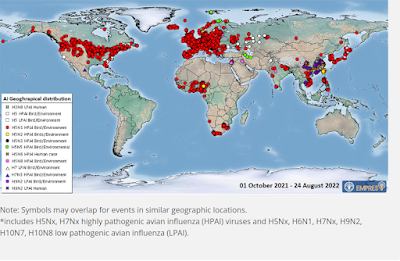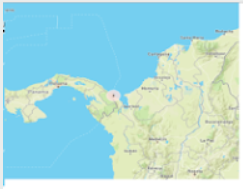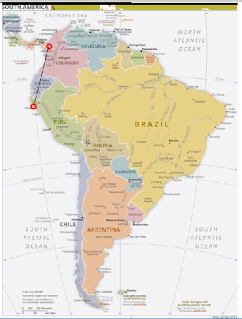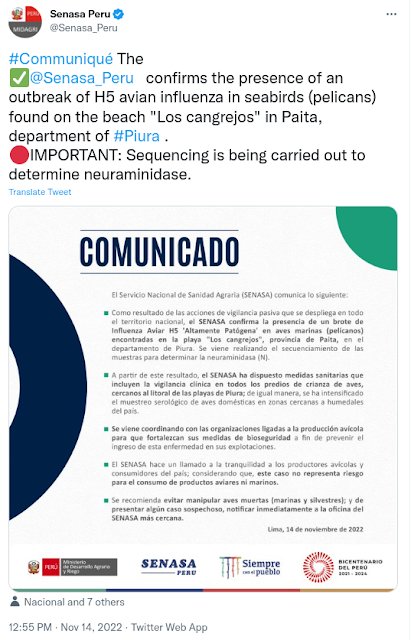Peru: SENASA Reports HPAI H5 In Pelicans

#17,124
Prior to 2017, HPAI H5 was only found in the Northern Hemisphere, but in the spring of that year migratory birds in West Africa introduced it - first into several central African nations - and then carried it south across the equator to Zimbabwe and South Africa.
In late 2021, HPAI was reintroduced into North America for the first time in 7 years by migratory birds, and this time it has spread rapidly across the United States, Canada, and most recently Mexico.
Although Belize reported HPAI H5 over the summer, South America - until very recently - had gone unscathed. That is, until 3 weeks ago, when Colombia reported 2 outbreaks very near their border with Panama (see map below).

While these outbreaks encroached only a few miles into South America, this was a pretty good indication that infected migratory birds were traversing the Central Americas Flyway which runs 14,000 km from the Canadian arctic to the tip of Argentina.
Late yesterday, Peru's SENASA (National Agrarian Health Service) announced the detection of HPAI H5 among seabirds on "Los cangrejos" beach in Paita, nearly 1,000 miles to the south of the Colombian outbreaks. Additional sequencing is underway to determine the N (neuraminidase) type.

The agency's twitter announcement follows:

The Andean News Agency carried the following (translated) announcement overnight:
Senasa confirms outbreak of H5 avian influenza in pelicans found on Paita beach
Clinical surveillance has been arranged in the bird breeding farms, close to the coast of the Piura beaches
Piura, Nov. 14.
As a result of the passive surveillance actions carried out throughout the country, the National Agrarian Health Service of Peru (Senasa) confirms the presence of an outbreak of "highly pathogenic" H5 avian influenza in seabirds (pelicans) found in the "Los cangrejos" beach in Paita, department of Piura.
For this reason, sequencing is being carried out to determine neuraminidase (N), indicates the statement issued by Senasa , which has also ordered sanitary measures that include clinical surveillance in all bird-rearing farms, close to the coast of the beaches. from Piura.
In the same way, serological sampling of domestic birds has been intensified in areas close to wetlands in the country.
In addition, it has been coordinating with organizations linked to poultry production to strengthen their biosecurity measures, in order to prevent the entry of the aforementioned disease on their farms.
Senasa calls for peace of mind for poultry producers and consumers in Peru, "considering that this case does not represent a risk for the consumption of poultry or marine products," he says.
Finally, it recommends avoiding handling dead birds (marine and wild); and if a suspicious case is presented, immediately notify the nearest Senasa office.
South America has its own reservoir of (mostly low path) avian flu viruses (see PLoS One Avian influenza in Latin America: A systematic review of serological and molecular studies from 2000-2015).
The introduction of a highly promiscuous HPAI H5 into the mix has the potential to generate multiple new reassortments (see yesterday's blog Preprint: Rapid Evolution of A(H5N1) Influenza Viruses After Intercontinental Spread to North America), with unpredictable results.
Aside from Antarctica, Australia is the last continent still free of HPAI H5. But migratory birds visit down under every year, which led Wildlife Health Australia to issue the following advisory last September warning that ". . . there is likely a higher chance for an introduction of HPAI viruses into Australia compared to previous years . . . '.

Twenty years ago, HPAI H5 was still only a regional threat in Southeast Asia. It wouldn't make it to Europe until 2005, and from there it branched out to the Middle East, and Africa. It finally arrived (briefly) to North America in late 2014, but had vanished by the following summer.
Starting in 2016, through a series of reassortments, HPAI H5 clade 2.3.4.4b has acquired new abilities that have promoted its rapid spread around the globe. It has an increased avian host range, it can be carried long distances by some migratory birds, while killing others, and it is increasing its spillovers into mammals.
While we've been on the brink before with HPAI H5, only to see it recede, the virus continues to learn new tricks, and past performance is no guarantee of future results.
Stay tuned.
https://afludiary.blogspot.com/2022/...-pelicans.html

#17,124
Prior to 2017, HPAI H5 was only found in the Northern Hemisphere, but in the spring of that year migratory birds in West Africa introduced it - first into several central African nations - and then carried it south across the equator to Zimbabwe and South Africa.
In late 2021, HPAI was reintroduced into North America for the first time in 7 years by migratory birds, and this time it has spread rapidly across the United States, Canada, and most recently Mexico.
Although Belize reported HPAI H5 over the summer, South America - until very recently - had gone unscathed. That is, until 3 weeks ago, when Colombia reported 2 outbreaks very near their border with Panama (see map below).

While these outbreaks encroached only a few miles into South America, this was a pretty good indication that infected migratory birds were traversing the Central Americas Flyway which runs 14,000 km from the Canadian arctic to the tip of Argentina.
Late yesterday, Peru's SENASA (National Agrarian Health Service) announced the detection of HPAI H5 among seabirds on "Los cangrejos" beach in Paita, nearly 1,000 miles to the south of the Colombian outbreaks. Additional sequencing is underway to determine the N (neuraminidase) type.

The agency's twitter announcement follows:

The Andean News Agency carried the following (translated) announcement overnight:
Senasa confirms outbreak of H5 avian influenza in pelicans found on Paita beach
Clinical surveillance has been arranged in the bird breeding farms, close to the coast of the Piura beaches
Piura, Nov. 14.
As a result of the passive surveillance actions carried out throughout the country, the National Agrarian Health Service of Peru (Senasa) confirms the presence of an outbreak of "highly pathogenic" H5 avian influenza in seabirds (pelicans) found in the "Los cangrejos" beach in Paita, department of Piura.
For this reason, sequencing is being carried out to determine neuraminidase (N), indicates the statement issued by Senasa , which has also ordered sanitary measures that include clinical surveillance in all bird-rearing farms, close to the coast of the beaches. from Piura.
In the same way, serological sampling of domestic birds has been intensified in areas close to wetlands in the country.
In addition, it has been coordinating with organizations linked to poultry production to strengthen their biosecurity measures, in order to prevent the entry of the aforementioned disease on their farms.
Senasa calls for peace of mind for poultry producers and consumers in Peru, "considering that this case does not represent a risk for the consumption of poultry or marine products," he says.
Finally, it recommends avoiding handling dead birds (marine and wild); and if a suspicious case is presented, immediately notify the nearest Senasa office.
South America has its own reservoir of (mostly low path) avian flu viruses (see PLoS One Avian influenza in Latin America: A systematic review of serological and molecular studies from 2000-2015).
The introduction of a highly promiscuous HPAI H5 into the mix has the potential to generate multiple new reassortments (see yesterday's blog Preprint: Rapid Evolution of A(H5N1) Influenza Viruses After Intercontinental Spread to North America), with unpredictable results.
Aside from Antarctica, Australia is the last continent still free of HPAI H5. But migratory birds visit down under every year, which led Wildlife Health Australia to issue the following advisory last September warning that ". . . there is likely a higher chance for an introduction of HPAI viruses into Australia compared to previous years . . . '.

Twenty years ago, HPAI H5 was still only a regional threat in Southeast Asia. It wouldn't make it to Europe until 2005, and from there it branched out to the Middle East, and Africa. It finally arrived (briefly) to North America in late 2014, but had vanished by the following summer.
Starting in 2016, through a series of reassortments, HPAI H5 clade 2.3.4.4b has acquired new abilities that have promoted its rapid spread around the globe. It has an increased avian host range, it can be carried long distances by some migratory birds, while killing others, and it is increasing its spillovers into mammals.
While we've been on the brink before with HPAI H5, only to see it recede, the virus continues to learn new tricks, and past performance is no guarantee of future results.
Stay tuned.
https://afludiary.blogspot.com/2022/...-pelicans.html